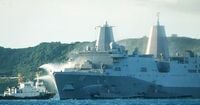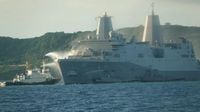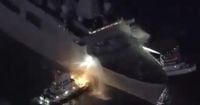On the evening of August 20, 2025, a fire erupted aboard the USS New Orleans, a San Antonio-class amphibious transport dock ship, as it was anchored off the coast of Okinawa, Japan, near the White Beach Naval Facility. The blaze, which began around 4 p.m. local time, raged for approximately 12 hours before being declared extinguished early the next morning, according to statements from the U.S. Navy’s 7th Fleet and corroborated by multiple news outlets including CNN, USNI News, and Business Insider.
As the fire broke out, the ship’s crew of more than 360 sailors sprang into action, fighting to contain the flames. Their efforts were quickly bolstered by the crew of the nearby USS San Diego, another San Antonio-class amphibious transport dock ship moored at White Beach. Japanese forces, including the Japan Maritime Self-Defense Force and the Japan Coast Guard, also responded to the call for help, providing critical support in the firefighting operation. Footage aired by Japanese broadcaster NHK showed tugs spraying water on the bow of the USS New Orleans as thick smoke billowed from the vessel.
The U.S. Navy’s 7th Fleet confirmed that two sailors suffered minor injuries during the incident and were treated aboard the ship. No other injuries were reported. The crew of the New Orleans will remain on board, though additional accommodations are available on the USS San Diego and ashore if needed, the Navy said in a statement quoted by USNI News.
Despite the successful extinguishing of the fire by 4 a.m. on August 21, the Japan Coast Guard noted that firefighting efforts continued until just after 9 a.m. local time to ensure the blaze was fully out. An investigation has been launched to determine the precise cause of the fire, but as of Thursday, no details about the origin or the extent of the damage had been released. Images from local media suggested that much of the firefighting was concentrated in areas of the ship used primarily for stores and berthing, but Navy officials have yet to comment on the structural impact.
The USS New Orleans, commissioned in 2007, is 684 feet long and displaces about 24,000 tons. It is designed to transport Marines, their equipment, and aircraft such as CH-46 Sea Knights and MV-22 Ospreys into combat zones. The vessel can carry up to 800 troops in addition to its crew. As part of the Navy’s forward-deployed amphibious force based in Sasebo, Japan, the ship plays a crucial role in regional security and logistics for the U.S. Seventh Fleet, which maintains a significant presence in the Pacific.
This incident has inevitably drawn comparisons to a devastating fire five years prior aboard another U.S. Navy vessel, the USS Bonhomme Richard. In July 2020, that amphibious assault ship caught fire while docked in San Diego, burning for more than four days and injuring over 60 sailors and civilians. The damage was so severe that the ship was ultimately decommissioned and scrapped. A Navy investigation into the Bonhomme Richard fire revealed a series of systemic failures in ship maintenance, crew training, and oversight. The report prompted the Navy to overhaul its fire prevention, inspection, and response protocols, particularly for ships in port.
Analysts and former Navy officials have pointed out that fires remain a persistent hazard on warships, which are packed with flammable materials and complex systems. Carl Schuster, a former U.S. Navy captain, told CNN that even a temporary loss of a ship like the New Orleans could impact the Navy’s readiness for months. He estimated that fire damage could keep the vessel out of action for 60 to 120 days, though the extent of the repairs required will depend on the results of the ongoing investigation.
“A fire of that extent used to be rare on US Navy warships,” Schuster remarked, emphasizing the need for the Navy to “review and improve its fire prevention and firefighting procedures.” The recent events serve as a stark reminder of the ever-present risks faced by crews at sea, even in peacetime, and the critical importance of vigilance and preparedness.
The White Beach Naval Facility, where the USS New Orleans was anchored at the time of the fire, serves as a major logistics and support hub for U.S. Marines and their equipment in the Pacific. The facility is strategically located on the east coast of Okinawa, a region that has long been central to U.S. military operations in Asia. The prompt and coordinated response from both American and Japanese forces highlights the close defense partnership between the two countries and their shared commitment to maritime safety.
While the incident did not result in any fatalities, it has nonetheless raised questions about the ongoing risks associated with operating large, complex warships. The Navy has stated that the crew will remain aboard the USS New Orleans for now, with additional services and berthing available on the USS San Diego and ashore if needed. The cause of the fire, as well as the full extent of the damage, remains under investigation by both U.S. and Japanese authorities.
The events of August 20 and 21 have also reignited debate within military circles about the effectiveness of the Navy’s post-Bonhomme Richard reforms. After the 2020 disaster, the Navy introduced new inspection and training procedures designed to prevent future fires and ensure rapid, coordinated responses when incidents do occur. Whether those measures were sufficient, or whether further changes are needed, will likely be a subject of scrutiny as more details about the USS New Orleans fire emerge.
For now, the focus remains on the well-being of the crew and the restoration of the ship’s operational capabilities. As the investigation continues, both the Navy and its Japanese partners are expected to review the incident closely, searching for lessons that can help prevent similar events in the future. The USS New Orleans, though battered, stands as a testament to the resilience and professionalism of its crew and the enduring strength of U.S.-Japan maritime cooperation.
As the Pacific fleet takes stock and repairs begin, the recent fire serves as a sobering reminder: even in times of relative peace, the challenges of life at sea demand constant vigilance and the highest standards of training and readiness.






